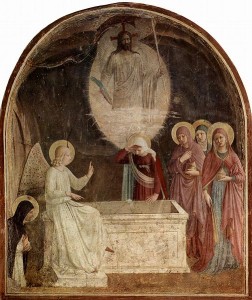
On Easter Sunday, in Tudor times, the candles in the church and around the sepulchre were extinguished, and then the church lights were re-lit by the priest, from a fire. The sepulchre was opened, and Christ’s resurrection was celebrated with a special mass.
The Easter Sunday mass marked the end of Lent, a period where people’s diets were restricted, so it was only natural to celebrate it with good food. Dairy products and meat were back on the menu, and people enjoyed roasted meats like chicken, lamb and veal.
Here is the account of Christ’s Resurrection from Matthew’s Gospel:
“In the end of the sabbath, as it began to dawn toward the first day of the week, came Mary Magdalene and the other Mary to see the sepulchre. And, behold, there was a great earthquake: for the angel of the Lord descended from heaven, and came and rolled back the stone from the door, and sat upon it. His countenance was like lightning, and his raiment white as snow: And for fear of him the keepers did shake, and became as dead men. And the angel answered and said unto the women, Fear not ye: for I know that ye seek Jesus, which was crucified. He is not here: for he is risen, as he said. Come, see the place where the Lord lay. And go quickly, and tell his disciples that he is risen from the dead; and, behold, he goeth before you into Galilee; there shall ye see him: lo, I have told you. And they departed quickly from the sepulchre with fear and great joy; and did run to bring his disciples word.
And as they went to tell his disciples, behold, Jesus met them, saying, All hail. And they came and held him by the feet, and worshipped him. Then said Jesus unto them, Be not afraid: go tell my brethren that they go into Galilee, and there shall they see me.” Matthew 28: 1-10. King James Bible
Alleluia! Christ is Risen!
He is risen indeed! Alleluia!